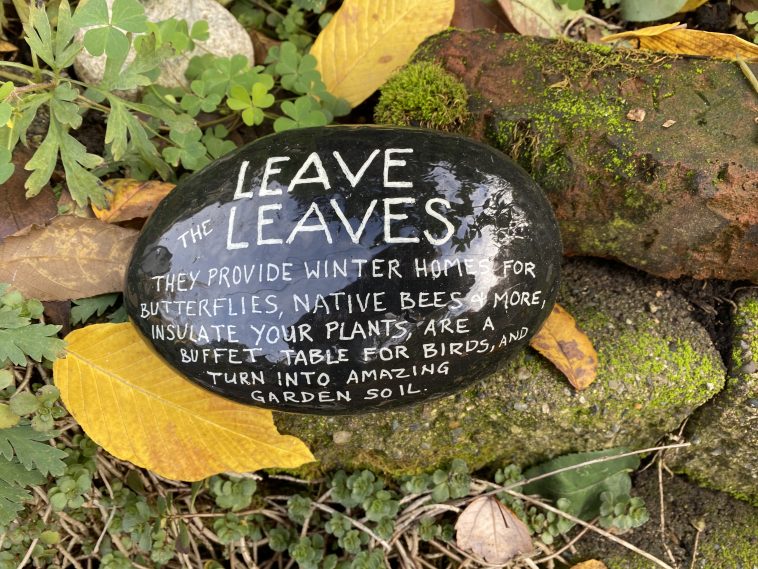The Apostrophe Blog
We are in major garden/yard cleanup mode here as is always the case at this time of year. It can, at times, be daunting even with the awesome help of The Amazing Phil four hours a month. Our garden helper, Phil, was here today, pruning the vine maples, the Japanese maples, the witch hazel, the redbud, and the lavender. Planting a batch of new perennials—coreopsis and a gorgeous dark-leaved penstemon in and around the front yard rain garden. And then there are the leaves. Most of the bigleaf maples’ 360,000 plus leaves have finally fallen thanks to gusting windy days this past week. Many are already raked into piles awaiting more weekly space in our Portland Composts! rolling green cart. And I have already filled my alley leaf composting project to the brim. But once again this year, we will also leave plenty of leaves in piles scattered around on the ground. As the painted rock in the photograph above attests, these are important, necessary habitats for insects and birds as they winter over here in the Pacific Northwest, the Xerces Society has a great deal of valuable information about this necessary overwintering and what we humans can do to help these creatures along. From their website:
- Great spangled fritillary and woolly bear caterpillars tuck themselves into leaf piles for protection from cold weather and predators.
- Red-banded hairstreaks lay their eggs on fallen oak leaves, which become the first food of the caterpillars when they emerge.
- Luna moths and swallowtail butterflies disguise their cocoons and chrysalises as dried leaves, blending in with the “real” leaves.
- Bumble bees create nests in cavities underground, in trees, or in brush piles. They prefer abandoned rodent burrows. At the end of summer, mated queen bumble bees burrow only an inch or two into the earth to hibernate for winter. An extra thick layer of leaves is welcome protection from the elements.
- 30% of native bees are tunnel-nesting, such as leafcutter and mason bees. These solitary-nesting species need narrow tunnels or other tiny spaces in dead wood, hollow stems, or brush piles.
- Yellow spotted millipede juveniles eat humus, the rich organic layer of decayed plants and animal matter at the surface of the forest floor.
- Stick insects drop more than 100 eggs from treetops that free-fall to the ground, where they overwinter in the leaf litter until spring. These eggs are disguised to look just like seeds. The ruse attracts ants, who take the seeds back to their nests and bury them, where the baby stick insects hatch safely beneath the soil.
So once again this year, I will be raking leaves around the base of every tree in my backyard habitat. I will be leaving some brush and woody debris where it falls. When I finally prune back all the dahlias at the end of this month, I will be stacking a pile of their stalks to be a refuge for overwintering insects in a corner of the garden. I will repurpose all of the leaves, hollow stems, tree branches, and brush. And come spring, their decayed wonderfulness will be further mulch for the continuing health of our pollinator habitat here in our corner of Portland, Oregon.
- Acceptance News: Red Door Magazine - November 10, 2025
- A Day of Shadows and Sun - November 10, 2025
- For the love of a watery landscape… - November 9, 2025

